Each-Phase Metering with Gas-Liquid Stratified Flow Based on the Multi-Frequency Coriolis Principle
Abstract
:1. Introduction
2. Theoretical Background
2.1. Measuring Principle of Single-Frequency Coriolis Flowmeters
2.2. Error Sources of Measuring Gas-Containing Fluid by Single-Frequency Coriolis Flowmeters
3. Methodology
3.1. The Influence of GVF on Vibration Frequency Response of the Measuring Tube
3.2. The Influence of Flow Patterns on Vibration Frequency Response of the Measuring Tube
4. Deviation Correction Model Based on Multi-Frequency Coriolis Principle
4.1. Multi-Frequency Coriolis Principle
4.2. The Correction Model with Stratified Flow Based on the Multi-Frequency Coriolis Principle
4.3. Analysis of Correction Results
5. Comparison of Correction Results
6. Conclusions
Author Contributions
Funding
Conflicts of Interest
References
- Han, G.; Tan, C. Determination of oil well production rate by analysis of the real-time dynamometer card. In Proceedings of the SPE Annual Technical Conference and Exhibition, Society of Petroleum Engineers, Dubai, UAE, 26–28 September 2016. [Google Scholar]
- Mahmoud, M.; Azzi, A.; Ghendour, N.; Kharoua, N.; Khezzar, L.; AlHosani, E. Multiphase flow meters targeting oil & gas industries. Measurement 2020, 165, 108111. [Google Scholar]
- Zhu, H.; Rieder, A.; Lin, Y. An Innovative Technology for Coriolis Metering under Entrained Gas Conditions; Endress+Hauser Flowtec AG: KägenStr, Reinach, 2016. [Google Scholar]
- Tan, C.; Wu, H.; Dong, F. Mass flow rate measurement of oil-water two-phase flow by a long-waist cone meter. IEEE Trans. Instrum. Meas. 2013, 62, 2795–2804. [Google Scholar] [CrossRef]
- Zhang, F.; Dong, F.; Tan, C. High GVF and low pressure gas–liquid two-phase flow measurement based on dual-cone flowmeter. Flow Meas. Instrum. 2010, 21, 410–417. [Google Scholar] [CrossRef]
- Basse, N.T. A review of the theory of Coriolis flowmeter measurement errors due to entrained particles. Flow Meas. Instrum. 2014, 37, 107–118. [Google Scholar] [CrossRef]
- Hemp, J.; Kutin, J. Theory of errors in Coriolis flowmeter readings due to compressibility of the fluid being metered. Flow Meas. Instrum. 2006, 17, 359–369. [Google Scholar] [CrossRef]
- Gysling, D.L. An aeroelastic model of Coriolis mass and density meters operating on aerated mixtures. Flow Meas. Instrum. 2007, 18, 69–77. [Google Scholar] [CrossRef]
- Liu, R.P.; Fuent, M.J.; Henry, M.; Duta, M.D. A neuronal network to correct mass flow errors caused by two-phase flow in a digital Coriolis mass flowmeter. Flow Meas. Instrum. 2001, 12, 53–63. [Google Scholar] [CrossRef]
- Hemp, J.; Yeung, H. Viscosity-Corrected Flowmeter. U.S. Patent 7072775, 4 July 2006. [Google Scholar]
- Henry, M.; Tombs, M.; Zamora, M.; Zhou, F. Coriolis mass flow metering for three-phase flow: A case study. Flow Meas. Instrum. 2013, 30, 112–122. [Google Scholar] [CrossRef]
- Wang, L.; Yan, Y. Mass flow measurement of gas-liquid two-phase CO2 in CCS transportation pipelines using Coriolis flowmeters. Int. J. Greenh. Gas Control 2018, 68, 269–275. [Google Scholar] [CrossRef]
- Zhu, H. Application of Coriolis Mass Flowmeters in Bubbly or Particulate Two Phase Flows; University of Erlangen Nuremberg: Erlangen/Nuremberg, Germany, 2008. [Google Scholar]
- Zhu, H.; Rieder, A. A moving resonator model of Coriolis flowmeters for measuring two-phase flow. In Proceedings of the 5th International Symposium on Multiphase Flow, Heat Mass Transfer and Energy Conversion, Xi’an, China, 3–6 July 2005. [Google Scholar]
- Luo, R.; Wu, J. Fluid-Structure Coupling Analysis and Simulation of Viscosity Effect on Coriolis Mass Flowmeter; APCOM & ISCM: Singapore, 2013. [Google Scholar]
- Luo, R.; Dalson, G.A.; Cheong, K.B. Experimental Measurement and CFD Simulation for Characterization of Coriolis Flowmeter Performance. J. Phys. 2018, 1065, 092005. [Google Scholar]
- Hua, C.; Sun, S.; Yao, H.; Zhu, H.; Xing, L. A Wellhead Metering Based on Bubble and Resonance Coriolis Effect with Known Gas-Liquid Ratio. Measurement 2020, 155, 107563. [Google Scholar] [CrossRef]
- Schollenberger, F.; Weinstein, J.; Shepherd, D. Fluid Characteristic Determination of a Multi-Component Fluid with Compressible and Incompressible Components. U.S. Patent 9383242, 5 July 2016. [Google Scholar]
- Wang, T.; Baker, R. Coriolis flowmeters: A review of developments over the past 20 years, and an assessment of the state of the art and likely future directions. Flow Meas. Instrum. 2014, 40, 99–123. [Google Scholar] [CrossRef] [Green Version]
- Liu, J.; Wang, T.; Yan, Y. Investigations into the behaviours of Coriolis flowmeters under air-water two-phase flow conditions on an optimized experimental platform. In Proceedings of the IEEE International Instrumentation and Measurement Technology Conference (I2MTC), Houston, TX, USA, 14–17 May 2018. [Google Scholar]
- Mandhane, J.M.; Gregory, G.A.; Aziz, K. A flow pattern map for gas-liquid flow in horizontal pipes. Int. J. Multiph. Flow 1974, 1, 537–553. [Google Scholar] [CrossRef]
- Yaushev, A.A.; Taranenko, P.A.; Loginovskiy, V.A. Study of the Oscillation Modes of a Coriolis Flowmeter Using a Parametric Finite Element Model, Verified by the Results of Modal Testing. Procedia Eng. 2016, 150, 336–340. [Google Scholar] [CrossRef] [Green Version]
- Lips, S.; Meyer, J.P. Stratified flow model for convective condensation in an inclined tube. Int. J. Heat Fluid Flow 2012, 36, 83–91. [Google Scholar] [CrossRef] [Green Version]
- Lips, S.; Meyer, J.P. Void fraction measurement of stratified gas-liquid flow based on multi-wire capacitance probe. Exp. Therm. Fluid Sci. 2019, 102, 61–73. [Google Scholar]
- Xue, Y.; Li, H.; Hao, C.; Yao, C. Investigation on the void fraction of gas-liquid two-phase flows in vertically-downward pipes. Int. Commun. Heat Mass Transf. 2016, 77, 1–8. [Google Scholar] [CrossRef]
- Montoya-Hernández, D.J.; Vázquez-Hernández, A.O.; Cuamatzi, R.; Hernandez, M.A. Natural frequency analysis of a marine riser considering multiphase internal flow behavior. Ocean Eng. 2014, 92, 103–113. [Google Scholar] [CrossRef]
- Niknam, P.H.; Fiaschi, D.; Mortaheb, H.R.; Mokhtarani, B. An improved formulation for speed of sound in two-phase systems and development of 1D model for supersonic nozzle. Fluid Phase Equilibria 2017, 446, 18–27. [Google Scholar] [CrossRef]
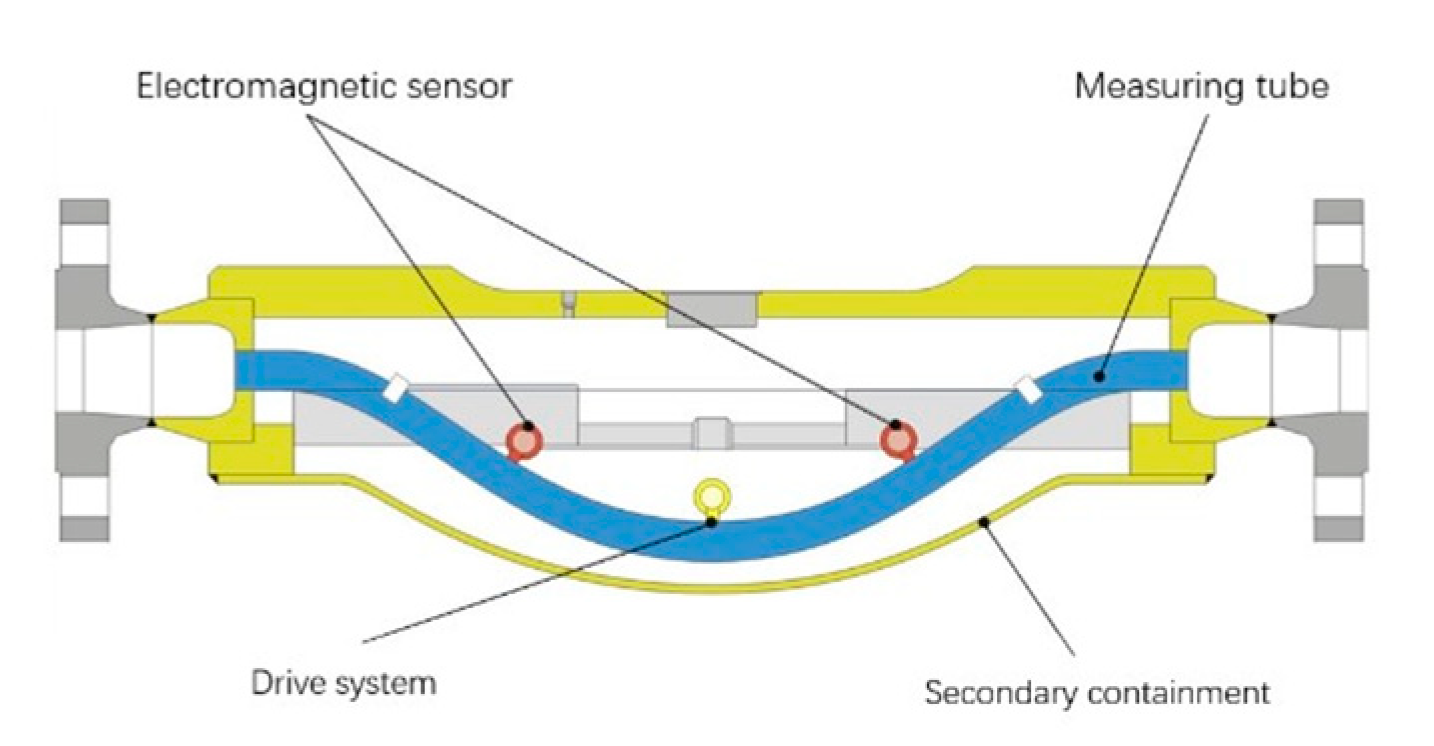
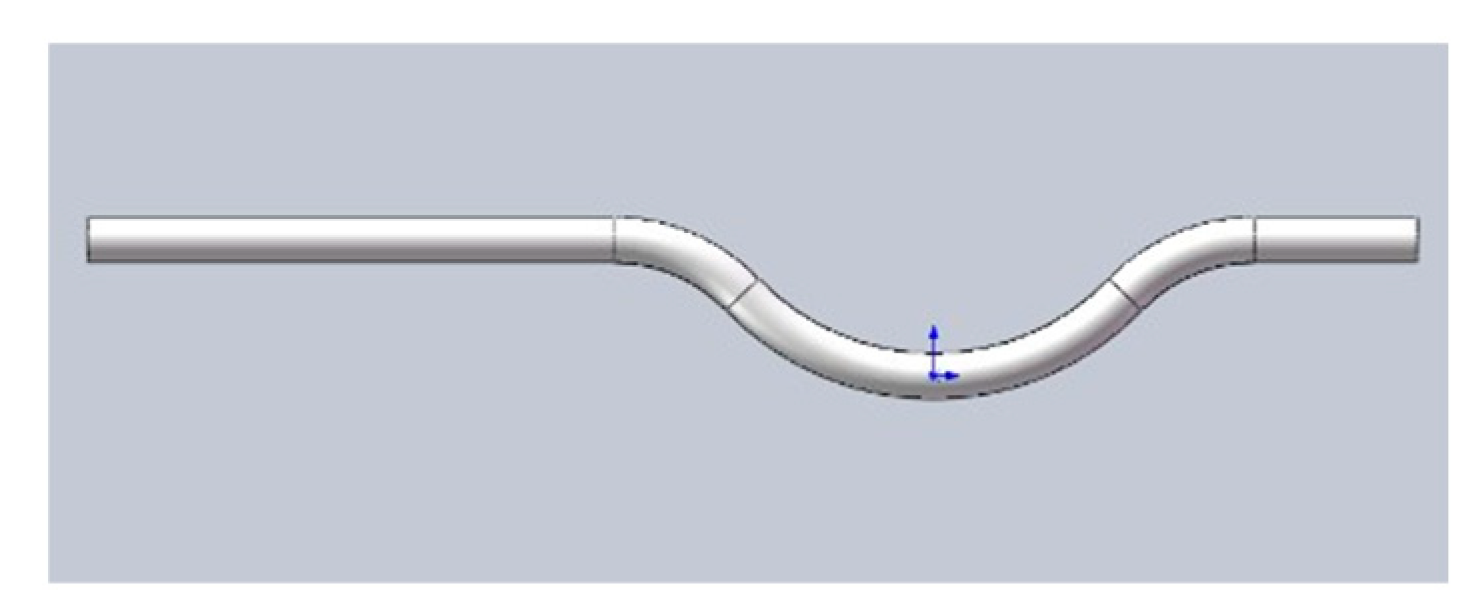
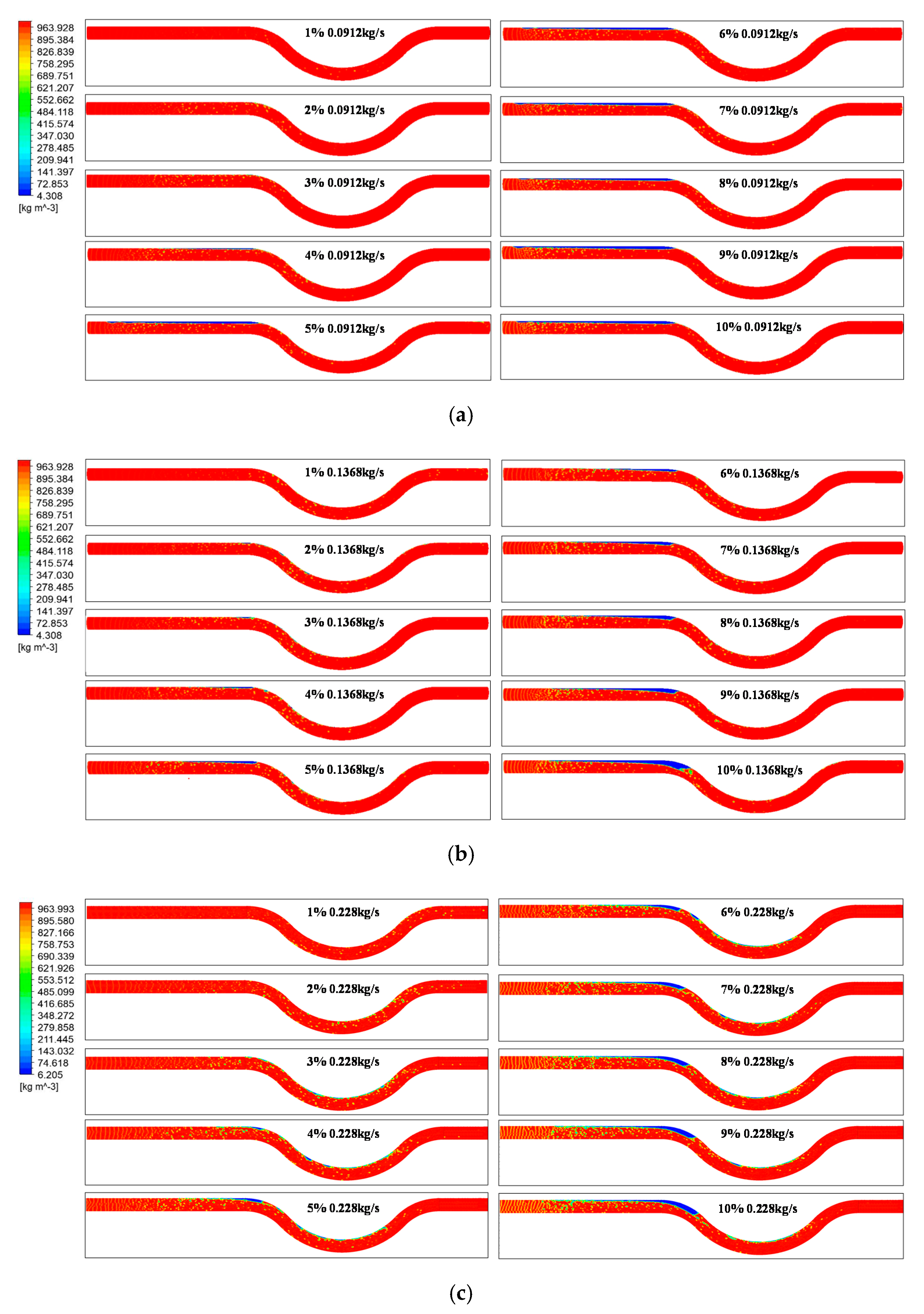

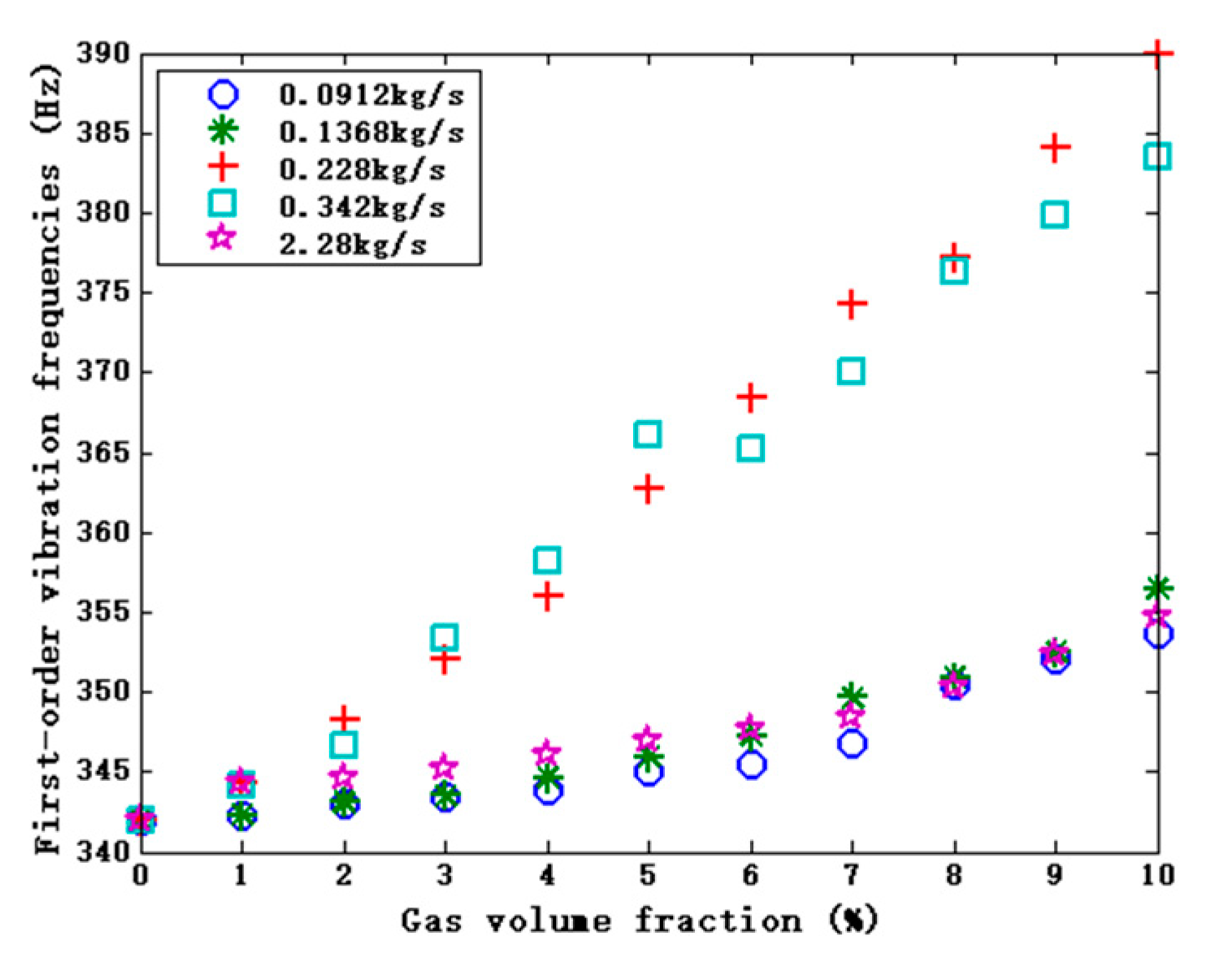
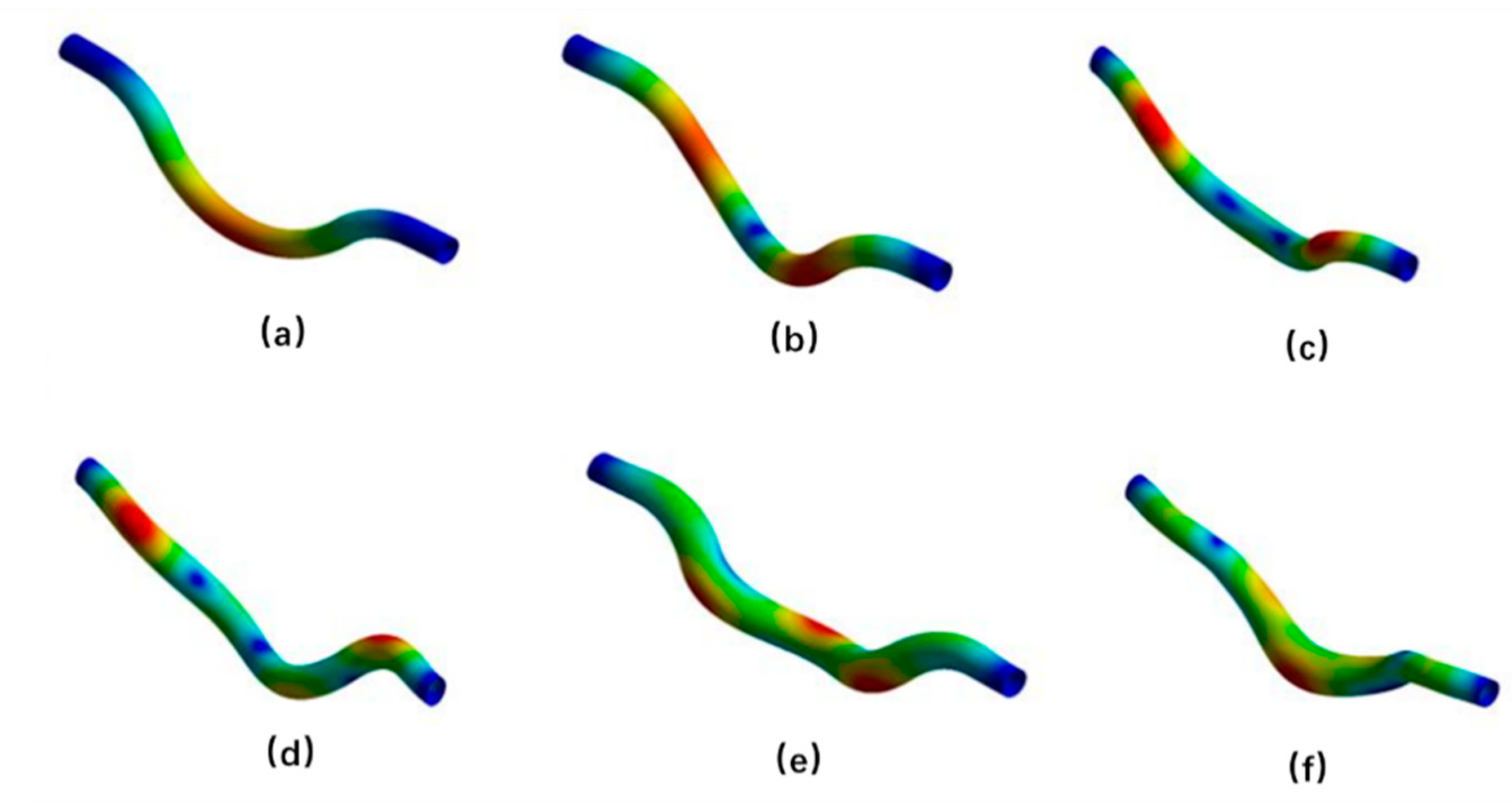


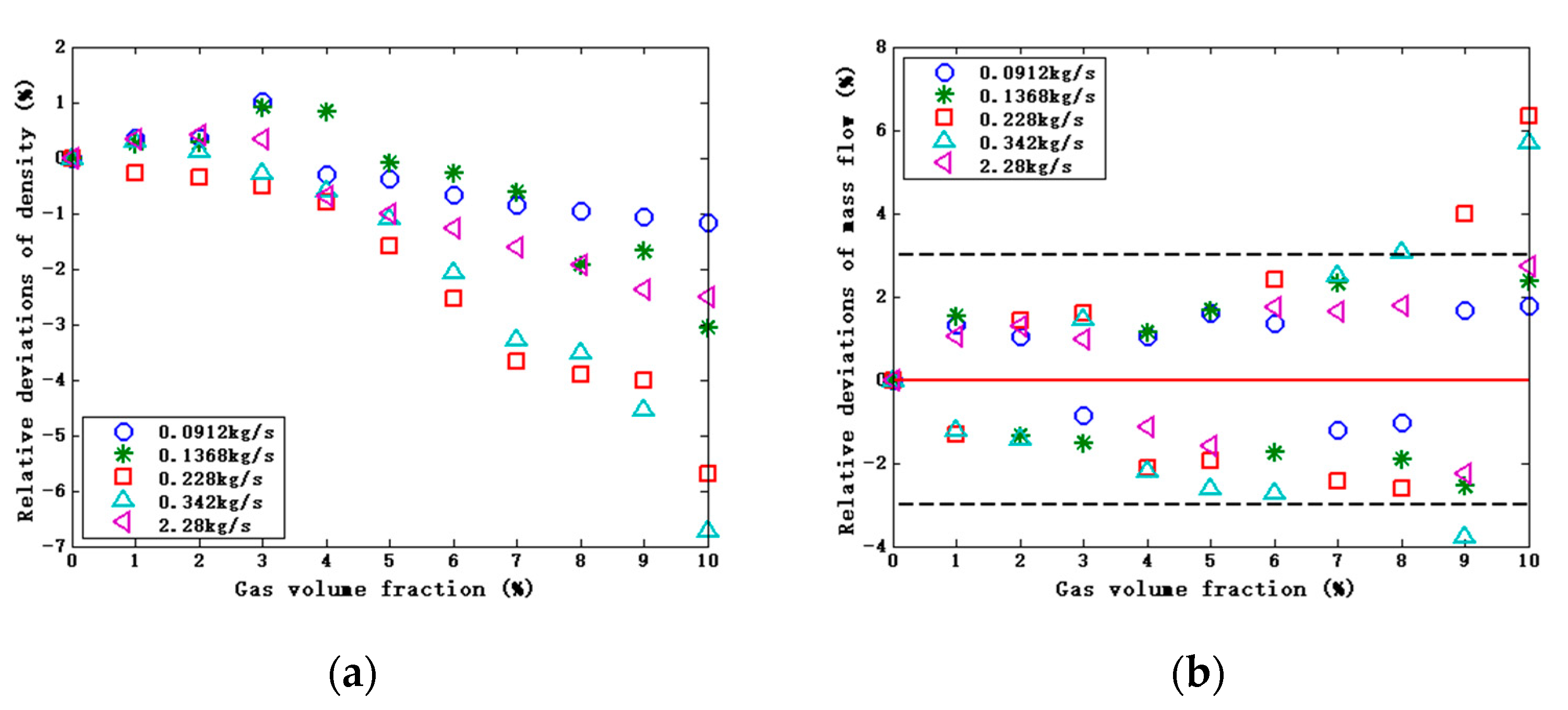
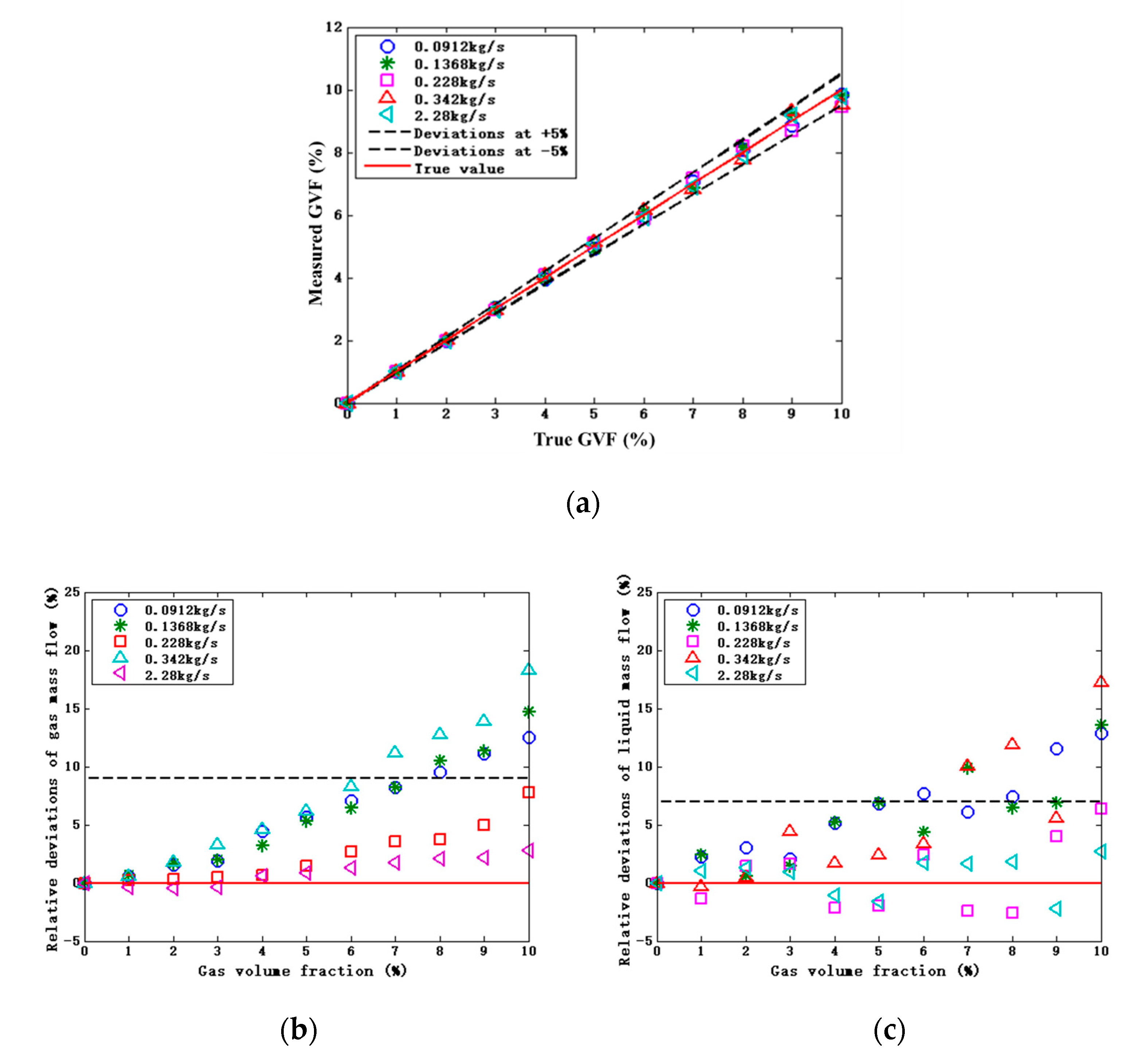
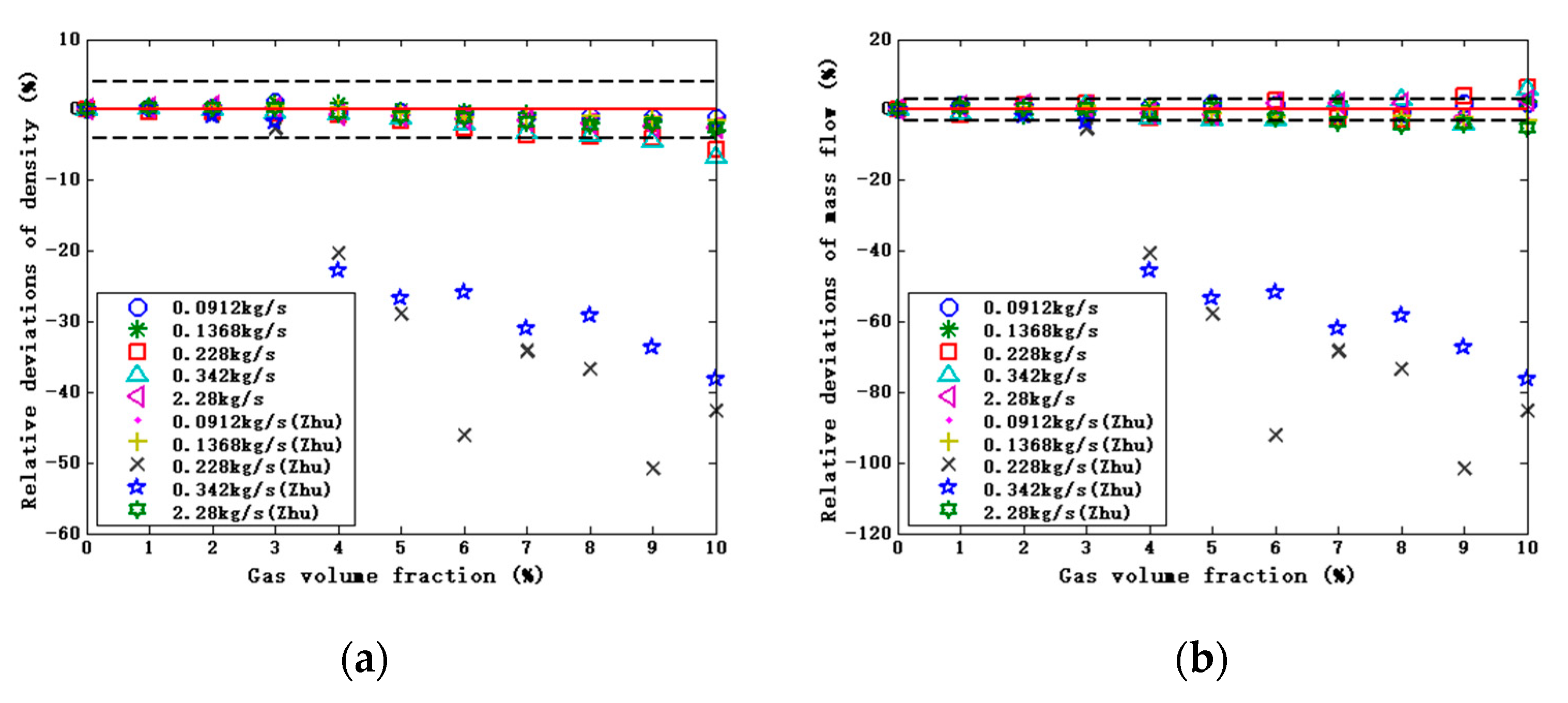
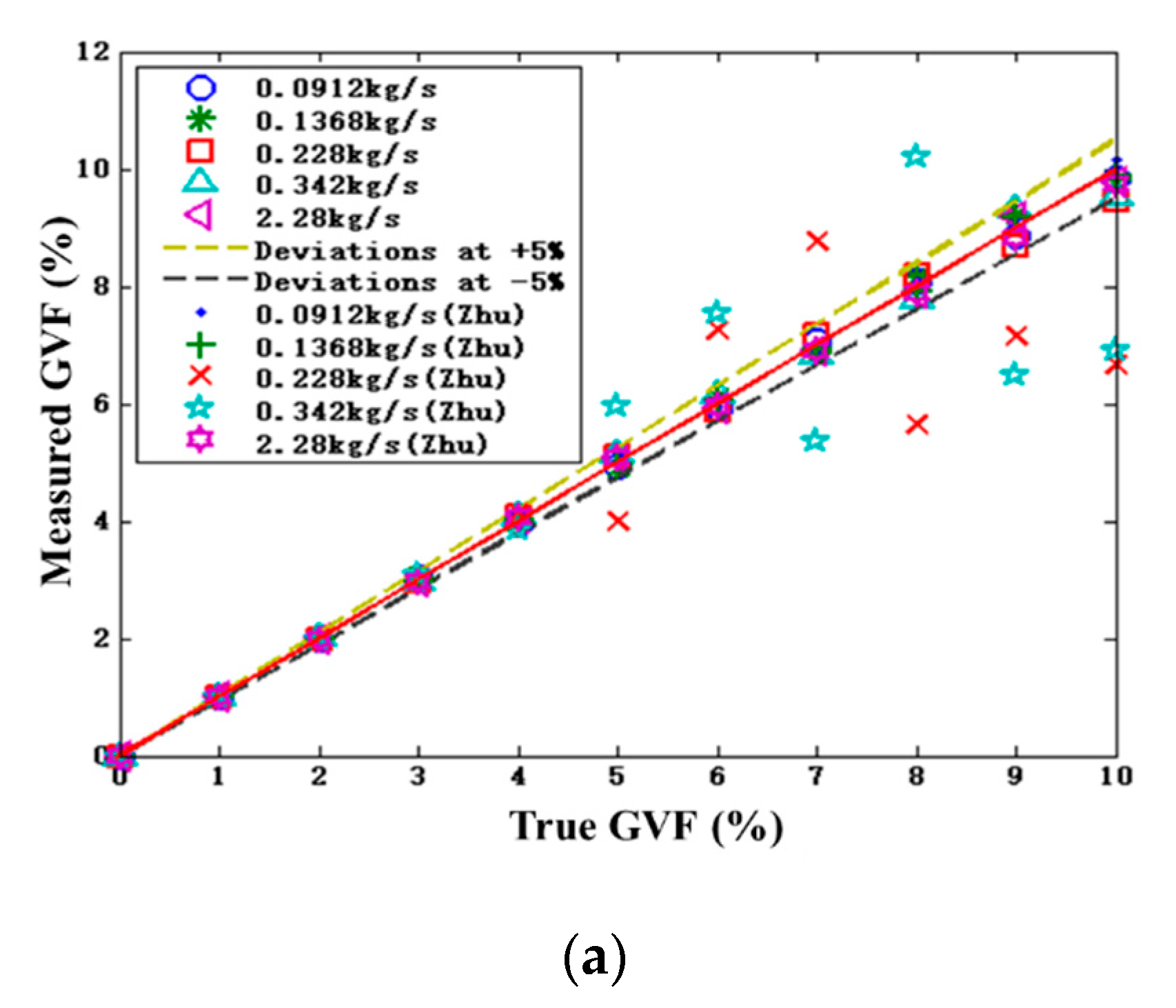
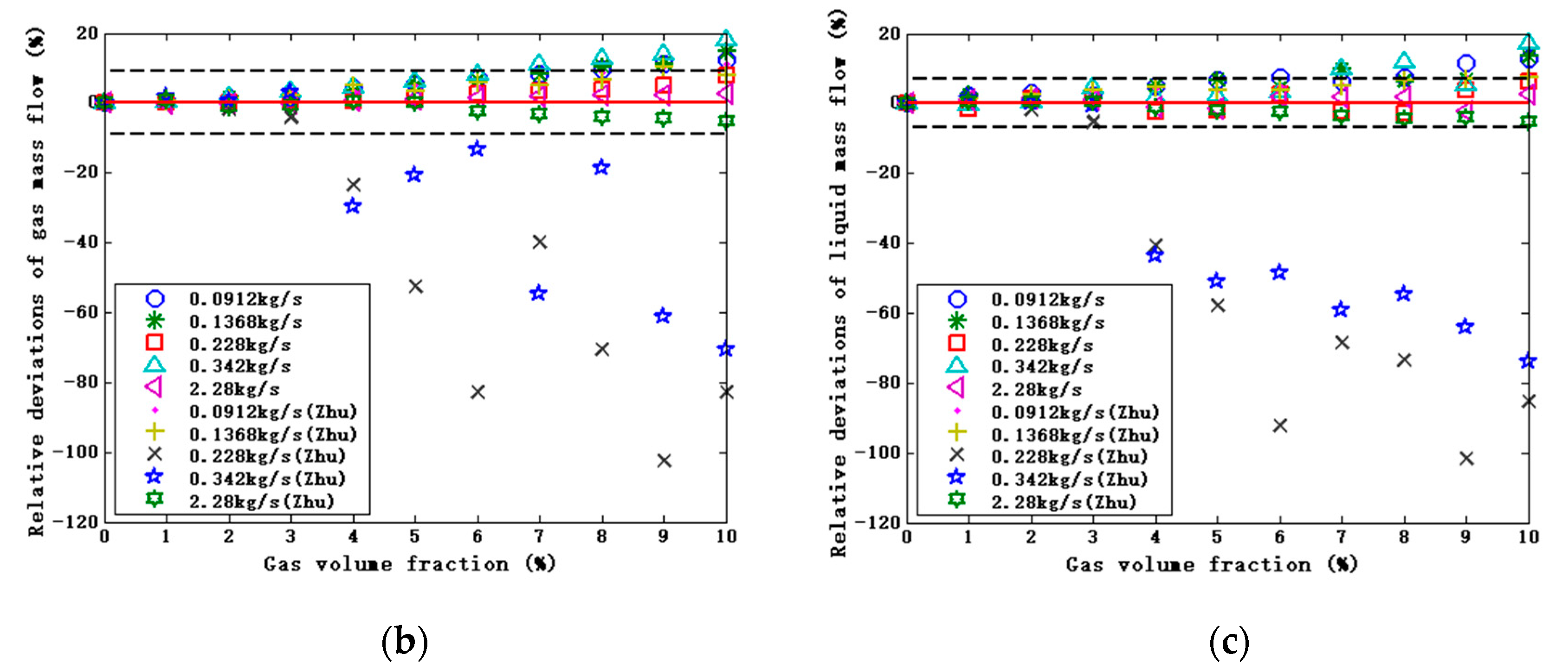
| Material | (kg/m3) | (Hz) | Viscosity (P) | t (°C) | P (bar) | Liquid Flowrate (t/d) |
|---|---|---|---|---|---|---|
| Water | 998.2 | 342.0 | 0.001003 | 20–60 | 4–25 | <100 |
| Methane | 4.3084 | 497.6 | 1.087 × 10−5 | 20–60 | 4–25 | / |
| No. | (kg/s) | (kg/s) | (10−5 kg/s) | Flow Patterns |
|---|---|---|---|---|
| 1 | 0.0910 | 0.0904–0.0822 | 0.3940–3.941 | Stratified |
| 2 | 0.1370 | 0.1356–0.1232 | 0.5910–5.911 | Stratified |
| 3 | 0.2283 | 0.2279–0.2278 | 0.9950–10.939 | Stratified |
| 4 | 0.3420 | 0.3389–0.3081 | 1.478–14.78 | Stratified |
| 5 | 2.281 | 2.280–2.278 | 9.949–109.4 | Bubble |
| Gas Volume Fraction (%) | ||||||
|---|---|---|---|---|---|---|
| 1 | 344.3 | 1045 | 1672 | 2388 | 3029 | 3148 |
| 2 | 346.2 | 1051 | 1681 | 2401 | 3045 | 3162 |
| 3 | 348.8 | 1058 | 1693 | 2418 | 3067 | 3183 |
| 4 | 352.0 | 1068 | 1708 | 2440 | 3093 | 3209 |
| 5 | 354.7 | 1076 | 1721 | 2458 | 3116 | 3231 |
| 6 | 358.5 | 1088 | 1739 | 2484 | 3148 | 3263 |
| 7 | 362.3 | 1099 | 1758 | 2510 | 3181 | 3294 |
| 8 | 367.2 | 1114 | 1781 | 2543 | 3222 | 3335 |
| 9 | 373.1 | 1132 | 1809 | 2583 | 3272 | 3386 |
| 10 | 379.9 | 1153 | 1842 | 2630 | 3331 | 3445 |
Publisher’s Note: MDPI stays neutral with regard to jurisdictional claims in published maps and institutional affiliations. |
© 2020 by the authors. Licensee MDPI, Basel, Switzerland. This article is an open access article distributed under the terms and conditions of the Creative Commons Attribution (CC BY) license (http://creativecommons.org/licenses/by/4.0/).
Share and Cite
Hua, C.; Yin, Y.; Sun, S.; Zhu, H.; Xing, L. Each-Phase Metering with Gas-Liquid Stratified Flow Based on the Multi-Frequency Coriolis Principle. Appl. Sci. 2020, 10, 7747. https://doi.org/10.3390/app10217747
Hua C, Yin Y, Sun S, Zhu H, Xing L. Each-Phase Metering with Gas-Liquid Stratified Flow Based on the Multi-Frequency Coriolis Principle. Applied Sciences. 2020; 10(21):7747. https://doi.org/10.3390/app10217747
Chicago/Turabian StyleHua, Chenquan, Yixiang Yin, Shuning Sun, Hao Zhu, and Lanchang Xing. 2020. "Each-Phase Metering with Gas-Liquid Stratified Flow Based on the Multi-Frequency Coriolis Principle" Applied Sciences 10, no. 21: 7747. https://doi.org/10.3390/app10217747





